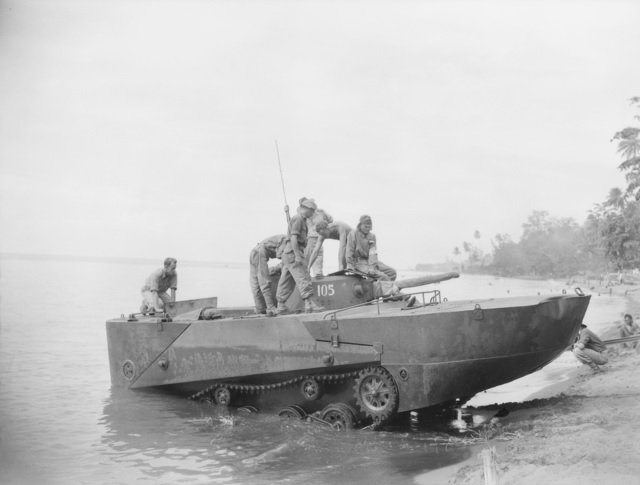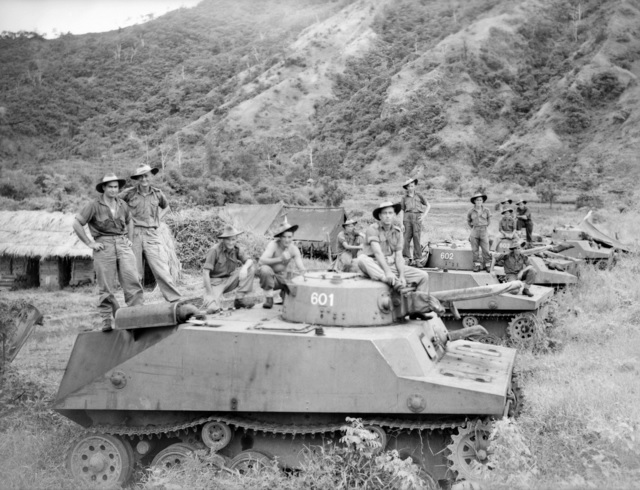Type 2 Ka-Mi
| Type 2 Ka-Mi | |
|---|---|
 A Type 2 Ka-Mi being tested by Australian soldiers in 1945 | |
| Place of origin | |
| Production history | |
| Designed | 1941 |
| Specifications | |
| Weight | 12.3 tons (9.15 tons without flotation pontoons) |
| Length | 7.42 meters (4.80 meters without flotation pontoons) |
| Width | 2.79 meters |
| Height | 2.34 meters |
| Crew | 5-6 |
| Armor | 6-13 mm |
| Main armament | Type 1 37 mm gun |
| Secondary armament | 2 × Type 97 7.7 mm machine guns |
| Engine | Mitsubishi air-cooled 6-cylinder diesel 115 hp (86 kW) |
| Suspension | Bell crank |
| Operational range | 200 kilometers |
| Speed | 37 km/h |
Contents
- 1 History and development
- 2 Design
- 3 Combat Record
- 4 Surviving Vehicles
- 5 See also
- 6 References
- 7 External links
History and development

Only 184 units of the Type 2 Ka-Mi were built, beginning in 1942, due to the number of complex components and due to the fact that it had to be nearly completely hand-built.[2]
Design
The Type 2 Ka-Mi was based on the Army's Type 95 Ha-Go light tank, but with an all-welded hull with rubber seals in place of the riveted armor. It was intended to be water-tight. Large, hollow pontoons made from steel plates were attached to the front glacis plate and rear decking to give the necessary buoyancy. The front pontoon was internally divided into eight separate compartments to minimize the effects of damage from flooding and shellfire. These flotation devices could be jettisoned from inside the tank once the tank landed and commenced ground combat operations.The Type 2 Ka-Mi's gun turret with a high-velocity Type 1 37 mm gun and a coaxial Type 97 light machine gun was able to rotate 360°. A second Type 97 light machine gun was located in the tank's bow. Occasionally Type 2 Ka-Mi's were armed with a pair of naval torpedoes; one on either side of the hull. The Type 2 Ka-Mi could also be launched from the deck of a submarine.[3]
The Type 2 Ka-Mi was capable of attaining speeds of 10 km/h in the water with a range of 150 km through two propellers situated at the rear of the hull, powered by the tank's engine. Steering was in the control of the tank commander, who operated a pair of rudders from the turret through cables.
That the crew included an onboard mechanic is an indication of the complexity of the design.
Combat Record
The Type 2 Ka-Mi came into active service after the initial campaigns of World War II, and was thus too late to be used in its original design mission of amphibious landings. Many units were assigned to naval garrison detachments in the South Pacific Mandate and in the Netherlands East Indies.The Type 2 Ka-Mi was encountered by the United States Marine Corps in the Marshall Islands and Mariana Islands, particularly on Guam, where it was dug into the ground and misused in static defense positions. It was also encountered in combat by U.S. Army forces at Aitape and Biak during the New Guinea campaign and during the fighting on the Philippine island of Leyte in late 1944. According to Ralph Zumbro in his book 'Tank Aces',several Ka-Mi were destroyed by Army LVT-1s off the coast of Leyte during history's only Amtank vs. Amtank action. A handful more were captured by Army troops on Luzon in 1945,but had not entered combat. A number of photos exist of these vehicles, as well as several others captured by Australian and Commonwealth troops. In common with most Japanese armor, it was no match for Allied tanks or anti-armor weapons.[2]
Surviving Vehicles
The Kubinka Tank Museum in Moscow, Russia has a Type 2 Ka-Mi on display, complete with its front and rear pontoons.A near complete hull is located in the bush near the airport on Babeldaob, Palau. Another interesting specimen is located in Koror area, Palau, between the Police Station and the Civic center. It's very interesting as it still has a heavy anti aircraft machinegun on the rear pontoon
See also
References
- Notes
- Bibliography
- Foss, Christopher (2003). Great Book of Tanks: The World's Most Important Tanks from World War I to the Present Day. Zenith Press. ISBN 0-7603-1475-6.
- Zaloga, Steven J. (2007). Japanese Tanks 1939-45. Osprey. ISBN [[Special:BookSources/1-84603-091-8|1-84603-091-8 [[Category:Articles with invalid ISBNs]]]] Check
|isbn=value (help). - Zumbro, Ralph (1997), Tank Aces, Pocket Books/Simon&Schuster, ISBN 0-671-53612-5

No comments:
Post a Comment